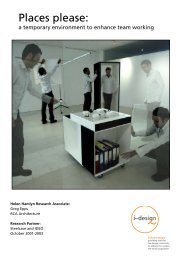Design for Dementia - Helen Hamlyn Centre - Royal College of Art
Design for Dementia - Helen Hamlyn Centre - Royal College of Art
Design for Dementia - Helen Hamlyn Centre - Royal College of Art
Create successful ePaper yourself
Turn your PDF publications into a flip-book with our unique Google optimized e-Paper software.
DESIGN FOR DEMENTIA<br />
STRUCTURE OF SPACE<br />
An environment that has not been specifically<br />
developed <strong>for</strong> residential dementia care can<br />
have an adverse effect on the way products<br />
and furniture fit into a care room. An analogy<br />
is to imagine trying to pass <strong>of</strong>f an <strong>of</strong>fice by<br />
filling it with bedroom furniture. Although<br />
functionally this space could work as a<br />
bedroom, it does not have the look and feel<br />
<strong>of</strong> one. It would look and feel like bedroom<br />
furniture has been placed in an <strong>of</strong>fice. Without<br />
a properly bedroom-designed environment,<br />
the furniture in the room as well as the person<br />
occupying it would feel wrong.<br />
To gain the benefits <strong>of</strong> a personalised<br />
bedroom, the skeletal structure <strong>of</strong> the room<br />
needs to express a different design language<br />
from the rest <strong>of</strong> the care home. When you<br />
enter someone’s bedroom, it should look, feel,<br />
smell and sound like you are stepping into<br />
someone’s own home, evoking all the senses<br />
to remind you that you are leaving the communal<br />
care facility and entering an individual’s<br />
private domain.<br />
Being able to personalise one’s environment<br />
within care does not just involve<br />
putting up a picture or bringing in a favourite<br />
armchair. It involves control <strong>of</strong> the environment<br />
in its totality and, in the best-case<br />
scenario, would result in redecorating the<br />
entire room <strong>for</strong> every resident that moves in.<br />
However in almost all cases, this exercise<br />
would be too expensive, time-consuming and<br />
disruptive within the care home.<br />
To address these three obstacles to<br />
effective personalisation <strong>of</strong> the care room<br />
environment, we can draw on some <strong>of</strong><br />
the lessons developed in the retail industry.<br />
While there are few end use parallels that<br />
can be drawn between personalisation in<br />
care and merchandising products <strong>for</strong> sale,<br />
there are comparable functionalities in terms<br />
<strong>of</strong> ease <strong>of</strong> use and modularity.<br />
Borrowed retail display techniques can<br />
give friends, family and carers the ability to<br />
completely renovate a space to a resident’s<br />
unique needs and personal tastes without<br />
requiring any specialist training, in a fraction<br />
<strong>of</strong> the time, with little or no budget<br />
and without causing any damage in the<br />
process. Care providers can benefit from the<br />
millions invested by the retail industry in<br />
developing customisable, modular display<br />
systems in order to improve the quality <strong>of</strong><br />
their care environments.<br />
By using a visually unobtrusive, wall<br />
mounted hook system such as the one shown<br />
here, an entire room can be personalised by<br />
family or carers as part <strong>of</strong> an introductory<br />
activity with a resident. Neutral colours on<br />
the walls can provide a base that residents<br />
and their helpers can later customise. This<br />
durable hook system means that the whole<br />
room benefits from customisation without<br />
undue disruption or cost.<br />
BEDROOM<br />
74

















